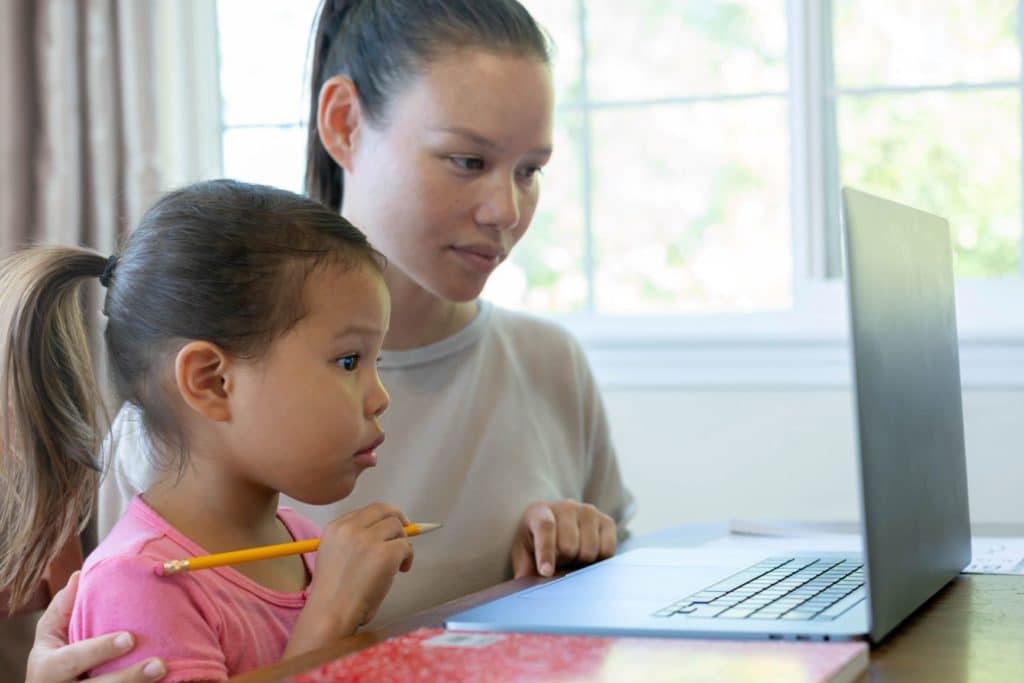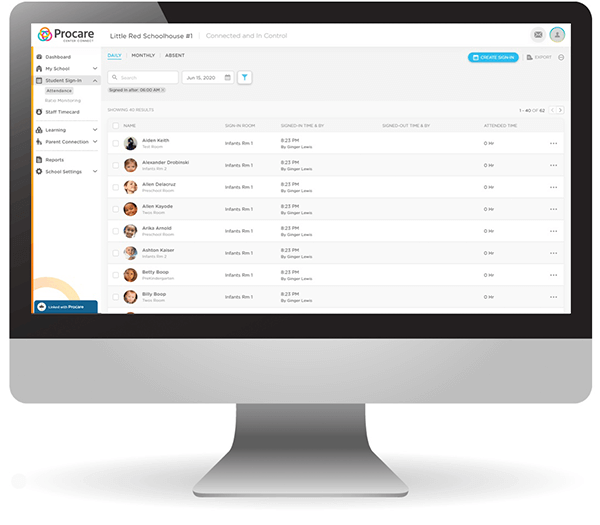
Hybrid schooling is already being talked about as the new normal for K-12 education – but how will this recent shift impact child care centers?
Keep reading to find out more about hybrid schooling and how child care centers can adapt their spaces, service offerings and operational practices to meet the needs of kids in hybrid learning programs.
What is Hybrid Schooling?
Hybrid schooling, also called blended learning, is a relatively new education model where students split their time between a physical classroom setting and online or home-based educational experiences. In schools that follow a hybrid learning model, teachers may interact with students in the classroom and/or facilitate online classes and asynchronous learning experiences.
Students in hybrid learning environments have greater control over when and where they consume course material, the pace at which they learn, and the learning pathways they choose, while still enjoying regular access to teachers as a valued educational resource.
Researchers at the Innosight Institute have identified six blended learning models that are currently being implemented in education settings:
- The Face-to-Face Driver Model – A model where teachers deliver most of the curriculum in person, but may incorporate supplementary or remediative online learning opportunities on a case-by-case basis.
- The Rotation Model – A hybrid schooling model where kids alternate between classes with an in-person teacher and self-paced online learning.
- The Flex Model – In the flex model, most of the school curriculum is delivered through digital platforms. When students require additional academic support, they may visit teachers at the school for individual or small-group tutoring.
- The Online Lab School Model – Some schools facing teacher shortages have adopted an online lab school model where students attend school in person and complete online classes with adult supervision, but without face-to-face instruction from teachers.
- The Self-Blend Model – Self-blended learning happens when students supplement their in-person schooling with additional online courses – usually ones that are not offered by their school.
- The Online Driver Model – In the online driver model of hybrid schooling, learning takes place online and teachers connect with students primarily via digital platforms. Students will complete their courses remotely, but may attend regularly scheduled check-ins with teachers to ask questions and review their progress. Students learning in this model may still occasionally attend school in person for field trips or extracurricular/supplementary activities.
Each of these models offers a slightly different approach to hybrid schooling, but many of them share common features such as the split between in-person and online course delivery and the availability of teachers to support the learning process.
Why is Hybrid Schooling on the Rise?
Hybrid schooling has become increasingly commonplace over the past 20 years. According to a 2011 study on the Rise of K-12 Blended Learning in the United States, 45,000 kids between kindergarten and grade 12 took at least one of their courses online in the year 2000. By 2009, more than three million kids in the K-12 age group were taking at least one online course. By 2018, 39 states had either opened virtual schools or created full-time blended learning programs (or both), and over 130,000 kids were enrolled in full-time blended learning schools.
In 2020, the trend toward hybrid learning has been significantly accelerated due to the coronavirus pandemic. Research conducted by MCH Strategic Data looked at school reopening plans for 12,504 districts (85% of all school districts in the U.S.) during COVID-19 and discovered that:
- Just 19% of districts planned to offer in-person classes
- 21% of districts planned to offer only digital classes to students
- 52% of districts planned to offer hybrid learning to their students
- 72% of districts planned to invest in technology that would expand access to online learning for students
- 74% of districts gave parents the option of withdrawing their child from in-person classes
During the COVID-19 pandemic, we’re seeing school districts implementing hybrid learning programs from K-12 that primarily follow the rotation model or the online driver model. These models provide kids with consistent access to teachers who can provide academic support while limiting in-person school attendance that may increase the risk of spreading the coronavirus.
How Does Hybrid Schooling Impact Child Care?

The widespread adoption of hybrid schooling means that children will spend less time in the classroom under the direct supervision of teachers and more time either in child care centers or at home with parents. When parents are unable to work from home, kids in blended learning programs will attend school on some days and child care centers on other days. Child care centers will see an increase in demand for daytime child care services and a preference among parents for centers with special accommodations for remote learning.
Centers that can adapt their physical spaces, programs and service offerings to support kids engaged with virtual learning will enjoy a competitive advantage in this new environment. Here’s how you can start preparing for success:
Child care administrators should assess community needs
Child care administrators are encouraged to contact their local school district to determine whether a hybrid schooling model has been adopted. Where hybrid schooling has been adopted, centers can interface with school administrators and parents in the community to assess whether there remains an unaddressed need for child care programs that support virtual learning.
Centers can expand or redesign spaces to support blended learning programs
Child care centers may need to expand, reconfigure or upgrade their facilities to support kids in blended learning programs. To effectively engage with their course work, kids will need access to a quiet space that is free from distractions, but still under the supervision of a child care provider. Centers may need to reorganize furniture or expand into an additional room to create appropriate spaces.
Centers may need new rules to enable virtual learning
As centers adapt their programs to accommodate virtual learning, they will need to develop new rules to help maintain a productive learning environment. Some possible examples could include:
- Laptops away during meal times to prevent them from getting dirty
- Kids watching online lessons must wear headphones to avoid distracting others
- Kids should only use their laptops to complete schoolwork and avoid accessing unrelated websites
- No sharing devices due to coronavirus risks
Centers need reliable internet to support hybrid schooling
Students in blended learning programs will use the internet at their child care center to access and complete course work. Child care centers will need a high-speed internet connection and sufficient monthly bandwidth to ensure that both students and staff members can get their work done without any frustrating slow-downs.
Child care providers will need basic IT skills
Child care providers will need basic computer skills to effectively supervise kids in virtual learning programs and help them address simple issues with their devices. Kids may also need help keeping their devices charged – centers can install additional plugs, set up a dedicated power bar, or provide back-up chargers to make sure everyone has what they need to be productive.
Hybrid schooling could increase coronavirus risks
At least one news article is suggesting that hybrid schooling might increase the spread of coronavirus infection in the community. The article correctly points out that students in hybrid schooling programs are likely to have more additional contacts outside of their classroom cohort or family that schools cannot monitor, and that this increases the risk of spreading COVID-19.
Child care centers can play a direct role here by following stringent safety protocols that limit the spread of COVID-19 within their facilities. The good news is that many centers are already well-equipped to address safety needs, as they’ve been operating with these protocols in place for months.
Child care attendance tracking is a key capability
Kids in hybrid schooling programs will spend two or three days each week in regular public school classes. They may attend your center for just one or two days each week, and they may not always be the same days! This can create additional complexity for child care administrators when it comes to accurately tracking attendance and correctly invoicing parents in each billing cycle.
Centers can address this challenge by adopting child care management software with attendance tracking capabilities. Student attendance tracking software makes it easy to review attendance records and reconcile them with invoices to ensure consistency and accuracy in your child care billing process.
Manage the Transition to Hybrid Schooling with Procare Solutions

Procare has spent the last 30 years building software solutions that help child care centers, before and after school programs, and in-home daycares meet the needs of families in their communities.
Our child care app offers digital attendance tracking, and attendance-based billing that can help you streamline processes and stay organized while providing child care services for kids in hybrid schooling models. We’ve even created a contactless check-in feature that lets parents complete the check-in process remotely and helps limit foot traffic in your facility to reduce the spread of COVID-19.
Are you ready to find out how Procare Solutions can help you provide better services for kids in hybrid learning programs? Talk to an Expert




